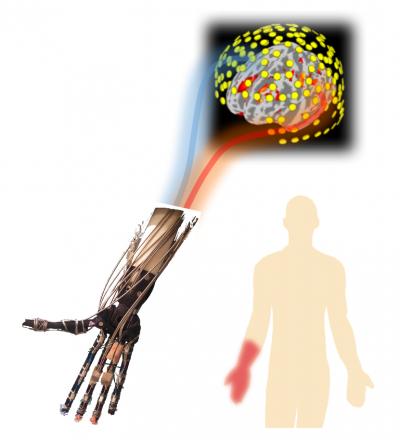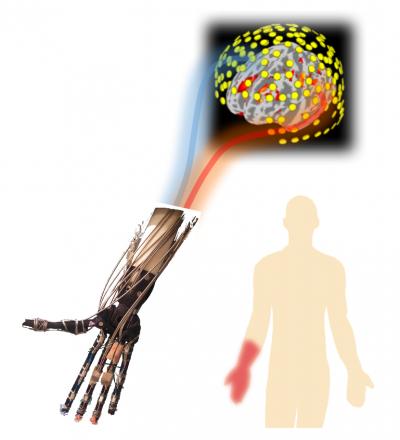
Credit: Osaka University
Osaka, Japan – Phantom limb pain is the pain experienced following loss of a limb, either from injury or amputation. This sensation of pain was previously thought to be caused by abnormal plasticity in the sensorimotor cortex of the brain, and rehabilitative therapies have focused on restoring normal motor function to relieve the pain. However, conflicting results left the question of whether and how phantom pain is caused by changes in sensorimotor activity unanswered.
In a new study, researchers based at Osaka University reported on their use of brain-machine interface (BMI) training with a robotic hand on 10 phantom limb patients to investigate the association between changes in symptomatic pain and cortical currents during phantom hand movements. The BMI decodes the cortical signals that instruct the affected hand to move. It then converts this decoded phantom hand movement into movement of the robotic neuroprosthesis. Previous research has shown that BMIs can precisely decode hand movements in real time.
Patients were asked to either open the robotic hand or grasp with it. The cortical currents activated by hand movements were measured using magnetoencephalography (MEG) signals. Results were compared with movement of the intact hand to check that motor information obtained from the sensorimotor cortex was specific. As expected, training with the prosthesis partially restored functioning of the affected hand and increased motor activity in the cortex. However, unexpectedly, participants reported a significant increase in the sensation of pain.
This approach provided a method for inducing localized changes in cortical activity and directly and reversibly studying the relationship with pain.
Indeed, when the patients were asked to move the phantom hand based on MEG signals decoded from movement of the intact hand, cortical sensorimotor activity was disrupted, reducing pain. In contrast with what was previously thought, these findings showed that pain is not reduced by reconstruction of motor function but by changes in cortical plasticity.
Five study participants found that BMI training reduced pain more than previous therapies, suggesting that this is a promising approach for treating phantom limb pain. The training also reduced pain from residual surgery in some patients, therefore may be used to treat other chronic pain conditions.
###
Media Contact
Saori Obayashi
[email protected]
81-661-055-886
@osaka_univ_e
http://www.osaka-u.ac.jp/en
############
Story Source: Materials provided by Scienmag




